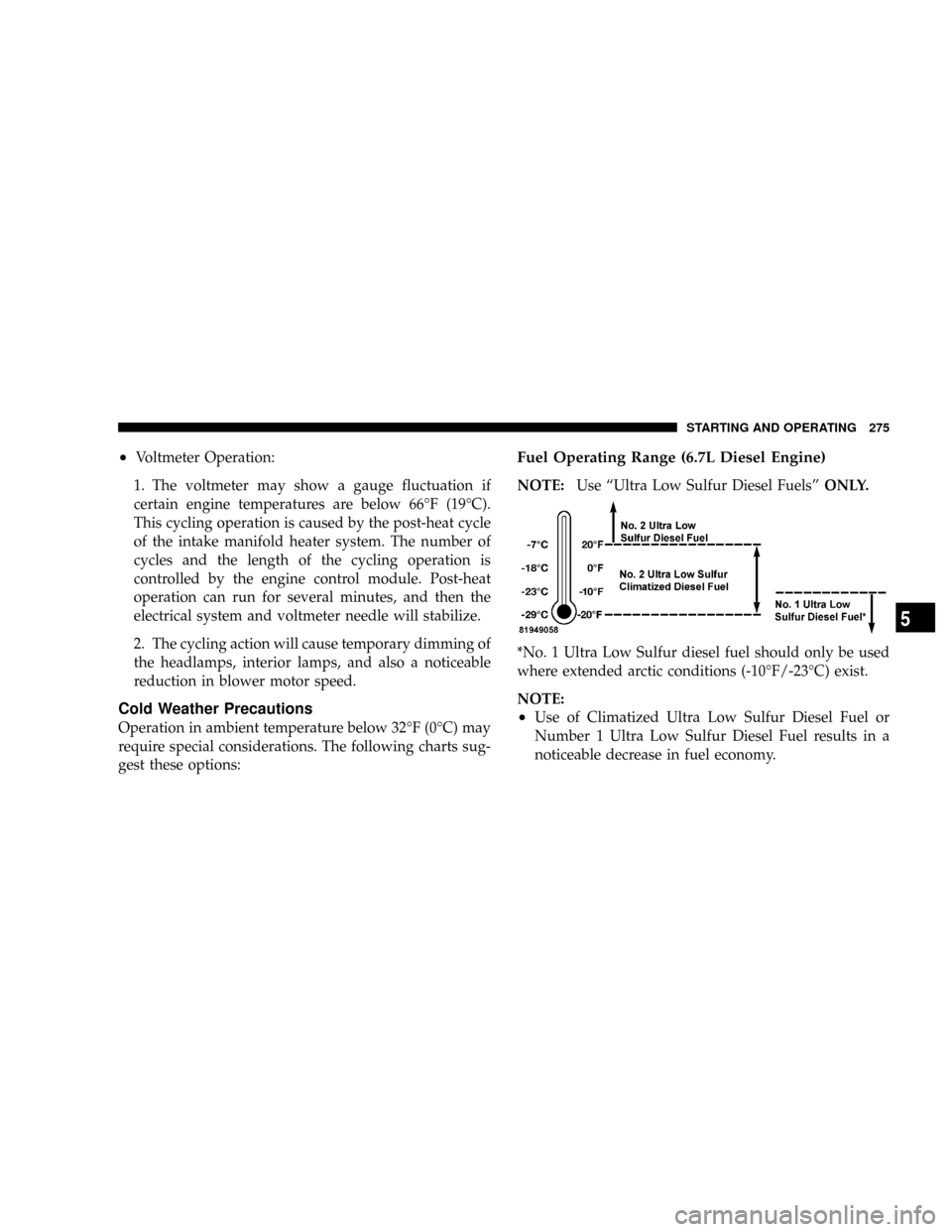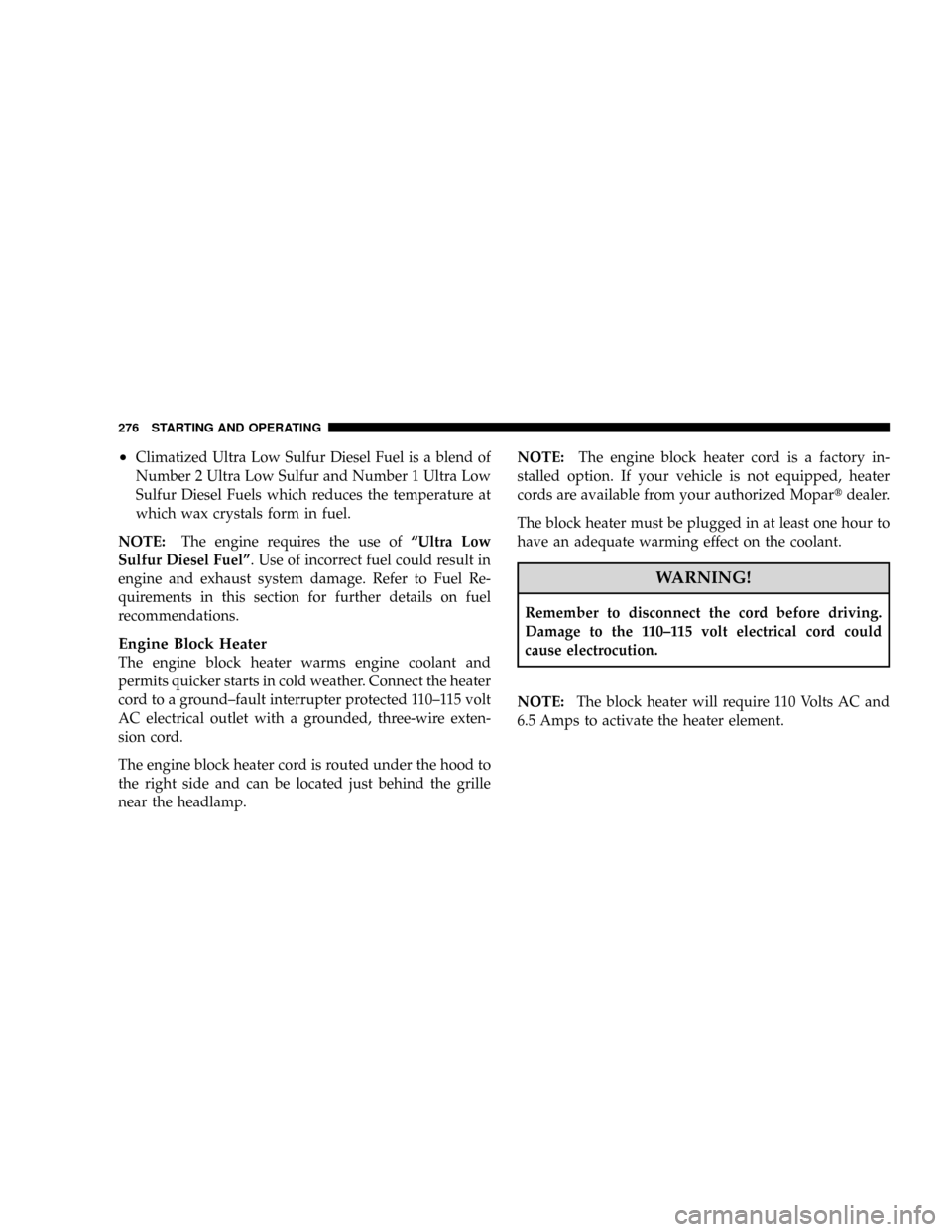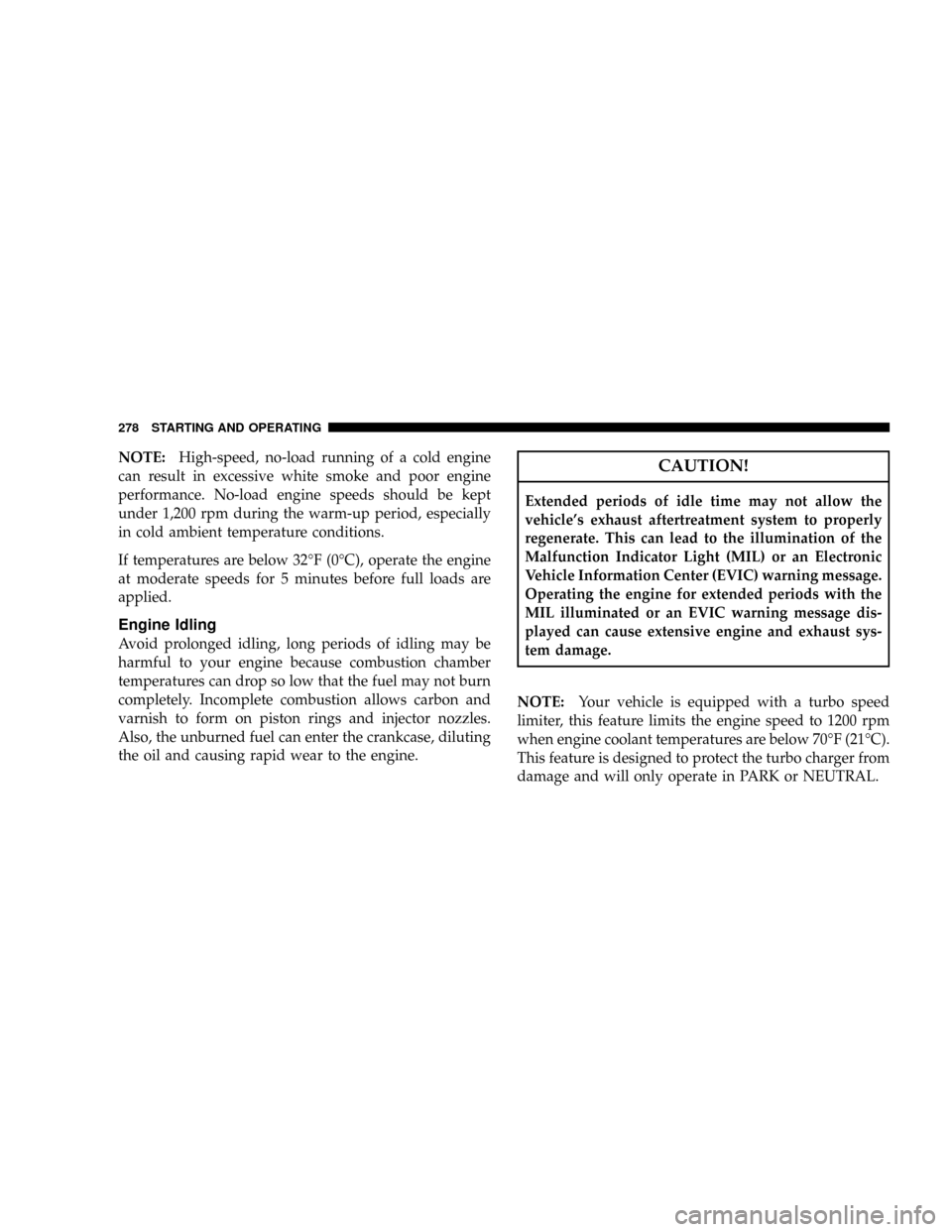Page 276 of 527
Starting Fluids
WARNING!
STARTING FLUIDS or flammable liquids are
NEVER TO BE USED in the CumminstDiesel (see
Warning label). Never pour diesel fuel, flammable
liquid, starting fluids (ether) into the air cleaner
canister, air intake piping, or turbocharger inlet in an
attempt to start the vehicle. This could result in a
flash fire and explosion causing serious personal
injury and engine damage.
The engine is equipped with an automatic electric air
preheating system. If the instructions in this manual are
followed, the engine should start in all conditions.
WARNING!
Do not leave children or animals inside parked
vehicles in hot weather. Interior heat build up may
cause serious injury or death.
NORMAL OPERATION (DIESEL ENGINE)
Observe the following when the engine is operating.
²All message center lights are off.
²Check Engine Lamp is off.
²Engine Oil Pressure is above 10 psi (69 kPa) at idle.
²Low Oil Pressure light is off.
274 STARTING AND OPERATING
Page 277 of 527

²Voltmeter Operation:
1. The voltmeter may show a gauge fluctuation if
certain engine temperatures are below 66ÉF (19ÉC).
This cycling operation is caused by the post-heat cycle
of the intake manifold heater system. The number of
cycles and the length of the cycling operation is
controlled by the engine control module. Post-heat
operation can run for several minutes, and then the
electrical system and voltmeter needle will stabilize.
2. The cycling action will cause temporary dimming of
the headlamps, interior lamps, and also a noticeable
reduction in blower motor speed.
Cold Weather Precautions
Operation in ambient temperature below 32ÉF (0ÉC) may
require special considerations. The following charts sug-
gest these options:
Fuel Operating Range (6.7L Diesel Engine)
NOTE:Use ªUltra Low Sulfur Diesel FuelsºONLY.
*No. 1 Ultra Low Sulfur diesel fuel should only be used
where extended arctic conditions (-10ÉF/-23ÉC) exist.
NOTE:
²Use of Climatized Ultra Low Sulfur Diesel Fuel or
Number 1 Ultra Low Sulfur Diesel Fuel results in a
noticeable decrease in fuel economy.
STARTING AND OPERATING 275
5
Page 278 of 527

²Climatized Ultra Low Sulfur Diesel Fuel is a blend of
Number 2 Ultra Low Sulfur and Number 1 Ultra Low
Sulfur Diesel Fuels which reduces the temperature at
which wax crystals form in fuel.
NOTE:The engine requires the use ofªUltra Low
Sulfur Diesel Fuelº. Use of incorrect fuel could result in
engine and exhaust system damage. Refer to Fuel Re-
quirements in this section for further details on fuel
recommendations.
Engine Block Heater
The engine block heater warms engine coolant and
permits quicker starts in cold weather. Connect the heater
cord to a ground±fault interrupter protected 110±115 volt
AC electrical outlet with a grounded, three-wire exten-
sion cord.
The engine block heater cord is routed under the hood to
the right side and can be located just behind the grille
near the headlamp.NOTE:The engine block heater cord is a factory in-
stalled option. If your vehicle is not equipped, heater
cords are available from your authorized Mopartdealer.
The block heater must be plugged in at least one hour to
have an adequate warming effect on the coolant.
WARNING!
Remember to disconnect the cord before driving.
Damage to the 110±115 volt electrical cord could
cause electrocution.
NOTE:The block heater will require 110 Volts AC and
6.5 Amps to activate the heater element.
276 STARTING AND OPERATING
Page 279 of 527

Block Heater Usage
A.Temperatures below 0ÉF (-18ÉC)
²Block Heater Required for 15W-40
²Block Heater Recommended for 5W-40
B.Temperatures below - 20ÉF (-29ÉC)
²Block Heater Required for 5W-40
Winter Front Usage
If a winter front or cold weather cover is to be used, a
percentage of the total grille opening area must be left
uncovered to provide sufficient air flow to the charge air
cooler and automatic transmission oil cooler. The per-
centage of opening must be increased with the increasing
ambient air temperature and/or engine load. If the
cooling fan can be heard cycling frequently, increase the
size of the opening in the winter front. A suitable cold
weather cover is available from your Mopartdealer.
Battery Blanket Usage
A battery loses 60% of its cranking power as the battery
temperature decreases to 0ÉF (-18É). For the same de-
crease in temperature, the engine requires twice as much
power to crank at the same RPM. The use of 120 VAC
powered battery blankets will greatly increase starting
capability at low temperatures. Suitable battery blankets
are available from your authorized Mopartdealer.
Arctic Operation
Where there are no provisions to keep the engine warm
when it is operating in ambient temperatures consistently
below (-10ÉF/-23ÉC), use 5W-40syntheticengine oil and
fuel that meets the requirements in Section 7, ªMainte-
nance Procedures,º Engine Oil Selection.
Engine Warm-Up
Avoid full throttle operation when the engine is cold.
When starting a cold engine, bring the engine up to
operating speed slowly to allow the oil pressure to
stabilize as the engine warms up.
STARTING AND OPERATING 277
5
Page 280 of 527

NOTE:High-speed, no-load running of a cold engine
can result in excessive white smoke and poor engine
performance. No-load engine speeds should be kept
under 1,200 rpm during the warm-up period, especially
in cold ambient temperature conditions.
If temperatures are below 32ÉF (0ÉC), operate the engine
at moderate speeds for 5 minutes before full loads are
applied.
Engine Idling
Avoid prolonged idling, long periods of idling may be
harmful to your engine because combustion chamber
temperatures can drop so low that the fuel may not burn
completely. Incomplete combustion allows carbon and
varnish to form on piston rings and injector nozzles.
Also, the unburned fuel can enter the crankcase, diluting
the oil and causing rapid wear to the engine.
CAUTION!
Extended periods of idle time may not allow the
vehicle's exhaust aftertreatment system to properly
regenerate. This can lead to the illumination of the
Malfunction Indicator Light (MIL) or an Electronic
Vehicle Information Center (EVIC) warning message.
Operating the engine for extended periods with the
MIL illuminated or an EVIC warning message dis-
played can cause extensive engine and exhaust sys-
tem damage.
NOTE:Your vehicle is equipped with a turbo speed
limiter, this feature limits the engine speed to 1200 rpm
when engine coolant temperatures are below 70ÉF (21ÉC).
This feature is designed to protect the turbo charger from
damage and will only operate in PARK or NEUTRAL.
278 STARTING AND OPERATING
Page 281 of 527

NOTE:An optional driver-controlled high idle speed is
available on automatic transmission equipped vehicles
with speed control. This feature allows the driver to
select an elevated idle speed between 1100 and 1500
rpms. Your dealer can enable this feature.
The optional driver-controlled high idle speed will help
increase cylinder temperatures and provide additional
cab heat, however, may still cause the exhaust aftertreat-
ment system to not properly regenerate. Extended peri-
ods of idle time should be avoided.
NOTE:
²If ambient temperatures are low and the coolant
temperature is below 200ÉF (93ÉC), the engine idle
speed will slowly increase to 1000 RPM after 2 minutes
of idle, if the following conditions are met:
²foot is off brake pedal and throttle pedal
²automatic transmission is in Park (P)
²vehicle speed is zero
²Applying the throttle will cancel fast idle
²If the engine is equipped with an exhaust brake,
operating the exhaust brake at idle will greatly im-
prove warm up rate and will help keep the engine
close to operating temperature during extended idle.
CAUTION!
Use of aftermarket exhaust brakes is not recom-
mended and could lead to engine damage
STARTING AND OPERATING 279
5
Page 282 of 527

Stopping The Engine
Idle the engine a few minutes before routine shutdown.
After full load operation, idle the engine 3 to 5 minutes
before shutting it down. This idle period will allow the
lubricating oil and coolant to carry excess heat away from
the combustion chamber, bearings, internal components,
and turbocharger. This is especially important for turbo-
charged, charge air cooled engines.
NOTE:During engine shutdown on vehicles equipped
with manual transmissions, it is normal for the diesel
engine to resonate heavily for a moment during engine
shut off. When the engine is connected to a manual
transmission, this resonance causes loud gear rattle from
the transmission. This is commonly referred to as ªshut
down rattleº. The manufacturer recommends performing
engine shut down with the clutch pedal pushed to the
floor (clutch disengaged). When engine shut down is
performed in this manner the rattle is reduced (not
eliminated).Driving
ConditionLoadTurbo-
charger
TemperatureIdle Time
(min.) Be-
fore Engine
Shutdown
Stop and
GoEmpty Cool Less than
One
Stop and
GoMedium One
Highway
SpeedsMedium Warm Two
City Traffic Maximum
GCWRThree
Highway
SpeedsMaximum
GCWRFour
Uphill
GradeMaximum
GCWRHot Five
280 STARTING AND OPERATING
Page 283 of 527

Engine Speed Control
CAUTION!
Prevent overspeeding the engine going down hill.
When descending steep grades, use a combination of
gears and service brakes to control vehicle/engine
speed. Overspeed can cause severe engine damage.
Operating Precautions
Avoid Overheating The Engine
The temperature of the coolant (a mixture of 50%
ethylene-glycol and 50% water) must not exceed the
normal range of the temperature gauge (240ÉF/116ÉC)
with a 16 psi (110 kPa) radiator cap.
Usually the coolant temperature indicated during opera-
tion will be to the left of center in the normal range of the
gauge.
Avoid Low Coolant Temperature Operation
Continual operation at low coolant temperature below
the normal range on the gauge (140ÉF/60ÉC) can be
harmful to the engine. Low coolant temperature can
cause incomplete combustion which allows carbon and
varnish to form on piston rings and injector nozzles.
Also, the unburned fuel can enter the crankcase, diluting
the lubricating oil and causing rapid wear to the engine.
Cooling System Tips Ð Automatic Transmission
To reduce potential for engine and transmission over-
heating in high ambient temperature conditions, take the
following actions:
²City Driving Ð
when stopped, put transmission in neutral and increase
engine idle speed.
²Highway Driving Ð
reduce your speed.
STARTING AND OPERATING 281
5